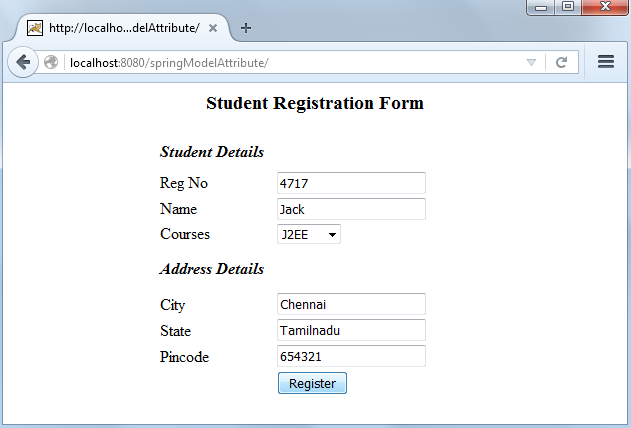Annotation based Form Handling:
Annotation that binds a method parameter or method return value to a named model attribute, exposed to a web view.
Can be used to expose command objects to a web view, using specific attribute names, through annotating corresponding parameters of an @RequestMapping method.
Can be used only on annotation based handler mapping @RequestMapping.
Using ModelAttribute on Method level.
Any request to this controller can share this attributes.
@ModelAttribute
public void addingCommonObjects(Model model)
{
model.addAttribute("msg", "Student Registration Details");
}Using ModelAttribute on Parameter level
Can be used only with this request
@RequestMapping("/Register.htm")
public ModelAndView getFormData(@ModelAttribute("ob")StudentBean sb, BindingResult result)
{
// BindingResult is used for validation purpose
// Print the entire data
if (!result.hasErrors())
{
System.out.println("Reg No..................." + sb.getRegno());
System.out.println("Name..................." + sb.getSname());
System.out.println("Course..................." + sb.getCourse());
System.out.println("City..................." + sb.getAddressBean().getCity());
System.out.println("State..................." + sb.getAddressBean().getState());
System.out.println("Pincode..................." + sb.getAddressBean().getPincode());
}
else
{
System.out.println("Error!!!!!!!!!!!");
}
ModelAndView model = new ModelAndView("page");
model.addObject("sb", sb); //both will work it will automatically injected to on object
//model.addObject("ob", sb);
return model;
}Complete Code
package com.candidjava.springmvc.controller;
import org.springframework.stereotype.Controller;
import org.springframework.ui.Model;
import org.springframework.validation.BindingResult;
import org.springframework.web.bind.annotation.ModelAttribute;
import org.springframework.web.bind.annotation.RequestMapping;
import org.springframework.web.servlet.ModelAndView;
import com.candidjava.springmvc.bean.StudentBean;
@Controller
public class StudentController
{
// **********************************************************
// ModelAttribute at method level : common for all requests
@ModelAttribute
public void addingCommonObjects(Model model)
{
model.addAttribute("msg", "Student Registration Details");
}
// ************************************************************************************************************
// ModelAttribute at parameter level
@RequestMapping("/Register.htm")
public ModelAndView getFormData(@ModelAttribute("ob")StudentBean sb, BindingResult result)
{
// BindingResult is used for validation purpose
// Print the entire data
if (!result.hasErrors())
{
System.out.println("Reg No..................." + sb.getRegno());
System.out.println("Name..................." + sb.getSname());
System.out.println("Course..................." + sb.getCourse());
System.out.println("City..................." + sb.getAddressBean().getCity());
System.out.println("State..................." + sb.getAddressBean().getState());
System.out.println("Pincode..................." + sb.getAddressBean().getPincode());
}
else
{
System.out.println("Error!!!!!!!!!!!");
}
ModelAndView model = new ModelAndView("page");
model.addObject("sb", sb); //both will work it will automatically injected to on object
//model.addObject("ob", sb);
return model;
}
}
Screenshot


Download